Metallic bond Study guides, Study notes & Summaries
Looking for the best study guides, study notes and summaries about Metallic bond? On this page you'll find 523 study documents about Metallic bond.
Page 4 out of 523 results
Sort by
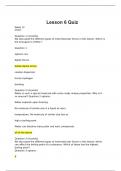
-
CHEM133 Week 13 Lesson 6 Quiz.docx
- Exam (elaborations) • 13 pages • 2023
- Available in package deal
-
- R568,16
- + learn more
1. Question: We discussed the different types of intermolecular forces in this lesson. Which is the strongest in CF2H2 ? 2. Question: Water is such a special molecule with some really unique properties. Why is it so unusual? 3. Question: We discussed the different types of intermolecular forces in this lesson, which can affect the boiling point of a substance. Which of these has the highest boiling point? 4. Question: If you have 2.00 x 103 J of energy, what mass (g) of solid butane (C4H10O) ...

-
Lattice Structure Properties Questions With 100% Correct Answers!!
- Exam (elaborations) • 2 pages • 2024
-
- R151,37
- + learn more
Metallic Lattice Structure - Metal atoms have a weak hold on their outer shell or valence electrons. This allows the electrons to move freely through the metal without being bound to one atom. Each metal atom becomes a positively charged ion. Opposite charges attract and this electrostatic force provides multidirectional bonding between the positive ions and the 'sea 'of loose electrons around them. Ionic Lattice Structure - this occurs when metallic elements bond with non-metallic elemen...
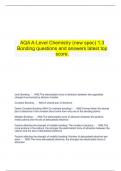
-
AQA A-Level Chemistry (new spec) 1.3 Bonding questions and answers latest top score.
- Exam (elaborations) • 5 pages • 2024
-
- R236,62
- + learn more
AQA A-Level Chemistry (new spec) 1.3 Bonding questions and answers latest top score. Ionic Bonding - ANS.The electrostatic force of attraction between two oppositely charged ions formed by electron transfer Covalent Bonding - ANS.A shared pair of electrons Dative Covalent Bonding (AKA Co-ordinate bonding) - ANS.Formed when the shared pair of electrons in the covalent bond come from only one of the bonding atoms. Metallic Bonding - ANS.The elect...

-
Lattice Structure Properties Questions and Verified Answers | Passed | A+
- Exam (elaborations) • 4 pages • 2024
-
- R196,84
- + learn more
Metallic Lattice Structure : Metal atoms have a weak hold on their outer shell or valence electrons. This allows the electrons to move freely through the metal without being bound to one atom. Each metal atom becomes a positively charged ion. Opposite charges attract and this electrostatic force provides multidirectional bonding between the positive ions and the 'sea 'of loose electrons around them. Ionic Lattice Structure : this occurs when metallic elements bond with non-metallic ...

-
General Chemistry ACS EXAM Review 168 Questions with Verified Answers,100% CORRECT
- Exam (elaborations) • 14 pages • 2024
-
- R236,62
- + learn more
General Chemistry ACS EXAM Review 168 Questions with Verified Answers Rutherford's Gold Foil Experiment - CORRECT ANSWER proposed that atoms consist of a tiny, massive, positive nucleus surrounded by electrons nucleus - CORRECT ANSWER contains all the positive charge and nearly all the mass of the atom James Chadwick - CORRECT ANSWER discovered the neutron cathode rays - CORRECT ANSWER move from negative electrode to positive electrode (like electrons in a voltaic cell) Thompson...
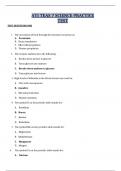
-
ATI TEAS 7 SCIENCE PRACTICE TEST WALDEN
- Other • 347 pages • 2023
-
- R577,63
- + learn more
1. The movement of food through the intestines is known as: A. Peristalsis B. Ileum translation C. Microvilli propulsion D. Flexure propulsion 2. The enzyme maltase does the following: A. Breaks down lactose to glucose B. Turns glucose into maltose C. Breaks down maltose to glucose D. Turns glucose into lactose 3. High levels of bilirubin in the blood stream can result in: A. Uric acid overexposure B. Jaundice C. Bile salt production D. Hepatic mutation 4. The symbol B on the peri...
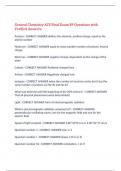
-
General Chemistry ACS Final Exam 89 Questions with Verified Answers,100% CORRECT
- Exam (elaborations) • 6 pages • 2024
-
- R215,78
- + learn more
General Chemistry ACS Final Exam 89 Questions with Verified Answers Protons - CORRECT ANSWER defines the element; positive charge; equal to the atomic number Neutrons - CORRECT ANSWER equal to mass number-number of protons; neutral charge Electrons - CORRECT ANSWER negative charge; dependent on the charge of the atom Cations - CORRECT ANSWER Positively charged ions Anions - CORRECT ANSWER Negatively charged ions Isotopes - CORRECT ANSWER when the number of neutrons varies but i...
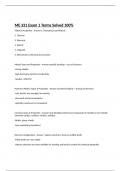
-
ME 331 Exam 1 Terms Solved 100%
- Exam (elaborations) • 8 pages • 2024
- Available in package deal
-
- R227,15
- + learn more
Material Properties - Answer 1. Mechanical and Physical 2. Thermal 3. Electrical 4. Optical 5. Magnetic 6. Deteriorative (chemical eg corrosion) Metals Types and Properties - Answer metallic bonding--> sea of electrons -strong, ductile -high thermal & electrical conductivity -opaque, reflective Polymers/Plastics Types & Properties - Answer Covalent bonding--> sharing of electrons -soft, ductile, low strength, low density -thermal & electrical insulators -optically transluc...
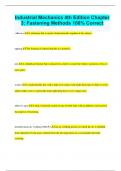
-
Industrial Mechanics 4th Edition Chapter 3: Fastening Methods 100% Correct
- Exam (elaborations) • 6 pages • 2024
-
- R189,26
- + learn more
Industrial Mechanics 4th Edition Chapter 3: Fastening Methods 100% Correct adhesive A substance that is used to bond materials together at the surface. tapping The forming of internal threads in a material. pin A cylindrical fastener that is placed into a hole to secure the relative positions of two or more parts. washer A small metallic disc with a hole in its center used under the head of a bolt or screw, and/or under a nut, to spread the load (tightening force) over a larger ar...

-
ACS Gen Chem 1 Exam 89 Questions with Verified Answers,100% CORRECT
- Exam (elaborations) • 7 pages • 2024
-
- R215,78
- + learn more
ACS Gen Chem 1 Exam 89 Questions with Verified Answers Extensive Property - CORRECT ANSWER Values that depend on how much you have Intensive property - CORRECT ANSWER Independent of size sample Density - CORRECT ANSWER Mass/volume Homogeneous mixture - CORRECT ANSWER Same throughout, indistinguishable parts Heterogeneous - CORRECT ANSWER Different parts, distinguishable parts Diatomic elements - CORRECT ANSWER N2, O2, H2, Cl2, Br2, I2 John dalton - CORRECT ANSWER Founded the...

R115 for your summary multiplied by 100 fellow students... Do the math: that's a lot of money! Don't be a thief of your own wallet and start uploading yours now. Discover all about earning on Stuvia


